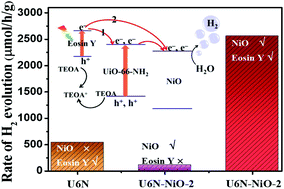Boosting visible-light photocatalytic H2 evolution via UiO-66-NH2 octahedrons decorated with ultrasmall NiO nanoparticles†
Abstract
Metal–organic framework (MOF)-based materials possess numerous attractive characteristics; however, the application of MOF-based photocatalysts in the area of visible-light photocatalytic H2 evolution is still in its infancy. Herein, we develop a series of novel UiO-66-NH2-based composites with embedded NiO nanoparticles via solvothermal treatment and subsequent calcination. Their characterizations demonstrate intimate lattice-level contacts between UiO-66-NH2 photocatalysts and NiO nanoparticles. By optimizing each component, even without noble metal loading, the U6N-NiO-2 sample (the weight ratio of NiO to U6N-NiO-2 is theoretically calculated to be ca. 10 wt%) with 15 mg eosin Y as a sensitizer causes an enhanced H2 generation rate of 2561.32 μmol h−1 g−1 under visible-light irradiation using TEOA as a sacrificial reagent; furthermore, its corresponding quantum efficiency is as high as 6.4% at 420 nm. The H2 evolution activity of U6N-NiO-2 is about 5 times higher than that of the UiO-66-NH2 photocatalyst (denoted as U6N) and 23 times higher than that of U6N-NiO-2 without sensitizer. It is demonstrated that the high efficiency originates from the visible-light generated electrons of eosin Y and UiO-66-NH2, the efficient separation of carriers by the cascaded band structure and more negative CB of NiO as well as the good dispersion of NiO nanoparticles on the octahedral skeleton. This study provides new insights for the design of MOF-based materials without noble metal loading for visible-light photocatalytic H2 evolution.



 Please wait while we load your content...
Please wait while we load your content...